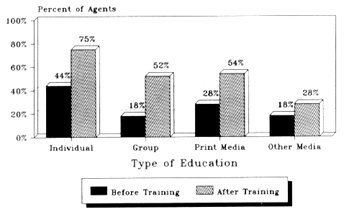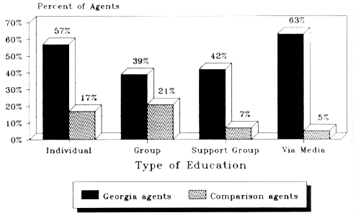Summer 1992 // Volume 30 // Number 2 // Feature Articles // 2FEA1
Training Impacts on Programming
Abstract
A training program directed at empowering Extension home economists to provide diabetes education does increase their involvement in diabetes educational activities. More Georgia Extension agents were willing to do or increase their diabetes programming after being trained and provided with appropriate material to educate consumers about diabetes self-management.
Extension programming typically begins with a client needs assessment and the availability of community resources to meet those needs.1 If an unmet need falls within the organizational mission, program development can begin by focusing the necessary university expertise, having or establishing credibility in the field, and perhaps most importantly, ensuring Extension agents have the skills and materials necessary to implement the program. This article describes how training and support provided to agents increased their diabetes educational activities, enabling the University of Georgia Cooperative Extension Service to address a significant statewide need.
Delivering Diabetes Education
Georgia is ranked seventh in the nation for prevalence of diabetes and 28th in the nation for deaths from diabetes.2 The diabetes-related mortality rate progressively increases with age and is much higher among blacks than whites. Basic care for a diabetic can cost from $1,400 to $1,600 a year. Costs may be 14 times higher if the person has diabetic complications.3 Ideally, a team of specialized health professionals provides diabetes education. This team may include a physician, nurse educator, dietitian, psychologist, and other health personnel. Due to uneven distribution of health care personnel, funding, and facilities, however, an enormous gap exists between the ideal and the reality of diabetes care for many Georgians.4
Georgia has one doctor for every 650 patients-the national average is one doctor per 523 patients. The state has one nurse per 190 patients (240 in rural areas) compared to the national average of one nurse per 133 patients.5 Seventy-three percent of the certified diabetes educators in Georgia and 75% of the registered dietitians practice in the five metropolitan areas of the state.6 By contrast, 66% of Extension home economists work in rural areas. Extension home economists provide basic nutrition education and have extensive experience facilitating community education groups. By training, involvement, and role in the community, the agent is ideally situated, as the health professional often isn't, to recognize problems and help people with implementing lifestyle changes required.
Program Development
In 1985, the Medical College of Georgia and the Cooperative Extension Service of the University of Georgia initiated a partnership to extend diabetes education opportunities throughout Georgia. The Medical College Comprehensive Diabetes Care Center (CDCC) staff and the Extension nutrition and health specialists developed diabetes training and support materials for county Extension home economists. This effort tried to increase Extension home economists' knowledge of diabetes, improve their ability to translate for Extension clients diabetes management recommendations made by health care professionals, and increase their diabetes programming efforts. Agents were offered two one- day trainings conducted jointly by the CDCC staff and Extension specialists. The first training introduced them to the physiology of diabetes, basic diabetes management skills, and guidelines for their involvement in diabetes educational programming. The second focused on more indepth nutrition management.
A diabetes textbook and resource manual were provided to all training participants. The textbook reviewed basic diabetes physiology and management, while the resource manual provided nutrition lesson plans and other educational materials to enhance local nutrition education. Additional support materials, including slide sets, videos, pamphlets, and a bimonthly newsletter for clients, were developed or purchased for agents to use. These materials could also be requested by Georgia agents who didn't attend the training.
At the training sessions, agents were encouraged to work with local health personnel to establish diabetes educational programs and support groups. They were shown how to help the client interpret the diabetes meal plan provided by a physician or dietitian, including menu planning, recipe selection and adjustment, label reading, holiday meals, and eating away from home.
Evaluating Training Impacts
The evaluation was done to determine whether training and resource support enhanced the efforts of local Extension home economists in diabetes education. The study was designed to determine the extent of programming efforts in Georgia before and after training and to compare this effort with a neighboring southeastern state with similar needs and population, but no extensive diabetes training program.
Two separate surveys were sent out to all county Extension home economists in Georgia (n=217; 94% response rate) and all Extension home economists with nutrition education responsibilities in the neighboring state (n=56; response rate 98%). Georgia agents were asked if they'd received diabetes training, if the training influenced diabetes programming, and what training materials were being used. The comparison survey determined only whether the agents did any diabetes education. Data were tested for significance using Pearson's chi-square to analyze the differences between the observed and expected frequencies of answers.7
Effects of Training
A total of 70% of Georgia agents attended both diabetes trainings. Of these participants, 72% reported they'd done some diabetes education in their counties before the training. Agents over age 40 and/or who had more than 10 years of service were more than twice as likely to have done some diabetes education before formal training. After training, 79% who attended either training said they increased their diabetes educational efforts. The age of the agent, years of service, and whether the agent was in an urban or rural county didn't significantly influence whether he or she conducted group or individual education after training (Figure 1).

Figure 1. Education done by agents.
Of all Georgia agents, whether trained or untrained, 71% used all or part of the diabetes textbook and 76% used all or part of the resource manual. Especially popular were the textbook chapters on diabetes physiology and nutrition management and the lesson plans on eating in restaurants and at parties. Trained agents were, however, two times more likely to use the resource manual and textbook than agents who didn't attend the trainings. Introducing the textbook and manual at the training helped agents become familiar with the contents and how it could support diabetes programming.
Forty-two percent of all agents reported they were currently involved with a diabetes support group in their county. They primarily provided educational materials (71%) and taught group classes (52%). Some also led the group, provided publicity, or planned meetings. Urban agents were significantly more likely to be involved with a support group than rural agents, but if involved, rural agents were significantly more likely to be support leaders, publicity providers, or meeting planners.
The training impact was also shown by comparison with agents from the other state. While 79% of trained Georgia agents conducted diabetes education, only 42% in the other state with no organized diabetes training had such programs (Figure 2). The education was usually done individually or with a group that didn't necessarily have diabetic members, such as homemaker groups. This was despite the fact these agents were older, more experienced, and had been specifically assigned nutrition educational responsibilities. Although 43% of these agents reported diabetic support groups existed in their counties, only seven percent had any involvement with them. The main reason for this lack of involvement-it wasn't part of the agent's job responsibilities. If no county support group existed, the main reason given was the county's lack of educational resources.

Figure 2. Type of diabetes education.
Summary
A training program directed at empowering Extension home economists to provide diabetes education does increase their involvement in diabetes educational activities. More Georgia Extension agents were willing to do or increase their diabetes programming after being trained and provided with appropriate material to educate consumers about diabetes self-management.
Studies are currently under way to determine the impact of the Extension diabetes educational program on both people with diabetes and physicians. The Georgia diabetes program depends on the direct involvement and support of medical personnel who believe in "extending" their knowledge and skill out into the community. It also depends on agents being trained and supported with appropriate educational materials. In this time of shrinking educational budgets, agent training is an important investment in the efficiency and effectiveness of all program development.
Footnotes
1. A. V. Peisher, Foodways to Better Health: Making a Difference in Your Community (Athens: University of Georgia, CES, 1984).
2. Centers for Disease Control, U.S., Department of Health and Human Services, Morbidity Weekly Report, XXXVIX (November 16, 1990), 805-808 and Department of Human Resources, Georgia Disease Patterns of the 1980's with Epidemiological Profiles (Atlanta: Georgia Center for Health Statistics, 1987).
3. "Diabetes Mortality Update," Statistical Bulletin, LXX (October-December 1989), 24-34.
4. M. E. Stachura and L. J. Sandlow, "Bridging the Gap-The Diabetes Research and Training Centers," The Diabetes Educator, IV (No. 1, 1978), 4-5.
5. T. W. Hodler and H. A. Schretter, The Atlas of Georgia (Athens: University of Georgia, 1986).
6. 1990 Directory (Chicago: American Association of Diabetes Educators, 1990).
7. SAS User's Guide, Release 6.03 (Cary, North Carolina: SAS Institute, 1988).
